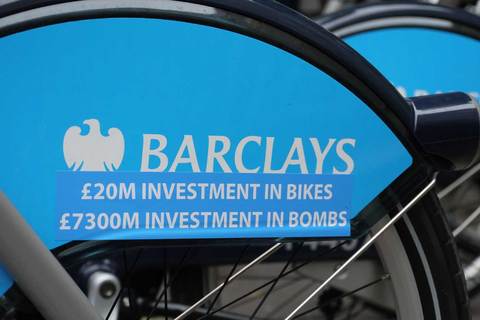
The invasion of the Boris bikes is complete. They stand on street corners, corralled like docile, futuristic horses in their blue harnesses. They’re good bikes – sturdy and solid – with a rather pleasing sit-up-and-beg riding position the better to survey the road around you. Undocking them is also quite fun, like something out of 2001: A Space Odyssey.
The name has become universal, which is only to be expected, launched as they were with all the pomp the bicycling mayor could muster. It’s not that we’ve forgotten that the bikes were originally Ken’s idea, but that Boris is a far more visible cyclist. The official name, ‘Barclays Cycle Hire’, was never going to take off, despite the lurid corporate livery.
Barclays have got a good deal from the £25 million they contributed to the £140 million scheme. As well as painting their company colours onto the streets, in the form of the pointless cyan-tarmac ‘cycle superhighways’ that run from the centre of London to various suburban hubs, they’ve also bedecked the machines with their logos.
How different from the first municipal bicycle scheme, conceived by the anarchist Provo movement in the Netherlands in the 1960s. The Provos proposed that central Amsterdam should be a car-free zone, and that the council should invest in 20,000 white bicycles that would be owned by the people and free for general use. The council rejected the plan but the Provos went ahead and bought 50 bikes which they released unlocked onto the streets, where they were promptly impounded by the police or stolen. (Some of their other schemes, like the one that urged drivers to ‘offset’ their carbon emissions by carrying small gardens around on the roofs of their cars, were delightfully Swiftian. Others were prescient: the Provos argued that prolific industrial polluters should be fined accordingly, and that the chimneys of the worst offenders should be painted white.)
Barclays’ flagrant appropriation of such a utopian idea was always going to cause tension, and the Boris bikes have become ripe targets for ‘subvertising’. ‘Situationist guerrilla teams’ have been doctoring the broadside ad space over the back wheel.

The Vélib’ scheme, the Parisian equivalent of the Boris Bikes, and the largest and longest running communal bicycle scheme around, has shown that regular investment is a necessary to maintain a fleet like this. A number of the French bikes are dredged from the Seine every month. Others are hung on trees like Christmas decorations, or ridden down stairs until they shake themselves to bits. One even turned up in Australia.
Barclays probably doesn’t give much of a shit about you, but if the bikes are going to continue to be useful then ongoing investment is a must. It’s unlikely that the money will be forthcoming from Boris.
via Invasion of the Boris Bikes « LRB blog. (thanks Mandiberg)

Invasion of the Boris Bikes « LRB blog
The invasion of the Boris bikes is complete. They stand on street corners, corralled like docile, futuristic horses in their blue harnesses. They’re good bikes – sturdy and solid – with a rather pleasing sit-up-and-beg riding position the better to survey the road around you. Undocking them is also quite fun, like something out of 2001: A Space Odyssey.
The name has become universal, which is only to be expected, launched as they were with all the pomp the bicycling mayor could muster. It’s not that we’ve forgotten that the bikes were originally Ken’s idea, but that Boris is a far more visible cyclist. The official name, ‘Barclays Cycle Hire’, was never going to take off, despite the lurid corporate livery.
Barclays have got a good deal from the £25 million they contributed to the £140 million scheme. As well as painting their company colours onto the streets, in the form of the pointless cyan-tarmac ‘cycle superhighways’ that run from the centre of London to various suburban hubs, they’ve also bedecked the machines with their logos.
How different from the first municipal bicycle scheme, conceived by the anarchist Provo movement in the Netherlands in the 1960s. The Provos proposed that central Amsterdam should be a car-free zone, and that the council should invest in 20,000 white bicycles that would be owned by the people and free for general use. The council rejected the plan but the Provos went ahead and bought 50 bikes which they released unlocked onto the streets, where they were promptly impounded by the police or stolen. (Some of their other schemes, like the one that urged drivers to ‘offset’ their carbon emissions by carrying small gardens around on the roofs of their cars, were delightfully Swiftian. Others were prescient: the Provos argued that prolific industrial polluters should be fined accordingly, and that the chimneys of the worst offenders should be painted white.)
Barclays’ flagrant appropriation of such a utopian idea was always going to cause tension, and the Boris bikes have become ripe targets for ‘subvertising’. ‘Situationist guerrilla teams’ have been doctoring the broadside ad space over the back wheel.
The Vélib’ scheme, the Parisian equivalent of the Boris Bikes, and the largest and longest running communal bicycle scheme around, has shown that regular investment is a necessary to maintain a fleet like this. A number of the French bikes are dredged from the Seine every month. Others are hung on trees like Christmas decorations, or ridden down stairs until they shake themselves to bits. One even turned up in Australia.
Barclays probably doesn’t give much of a shit about you, but if the bikes are going to continue to be useful then ongoing investment is a must. It’s unlikely that the money will be forthcoming from Boris.
via Invasion of the Boris Bikes « LRB blog. (thanks Mandiberg)